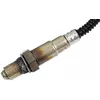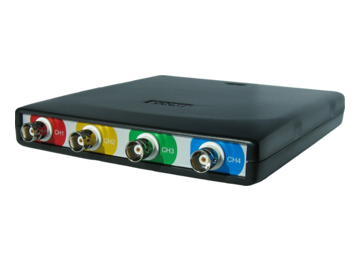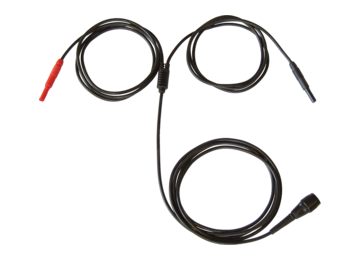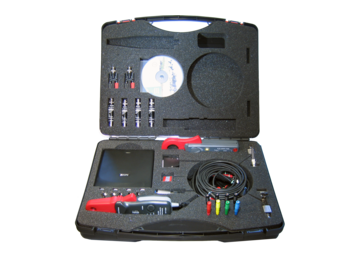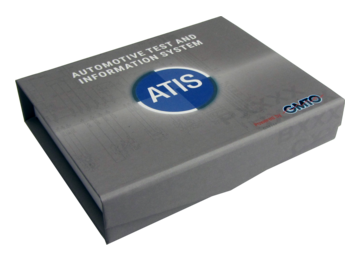Sensor information
| Type: | broadband zirconia oxygen sensor |
|---|---|
| Power supply: | 12 V from system relay |
| Signal type: | pump cell and measurement cell: amplitude varying, |
| heating element: duty cycle switched | |
| Signal level: | pump cell: -9 mA (rich) to 18 mA (lean), measurement cell: ~450 mV, |
| heating element: 0 V to 12 V |
Workings of a broadband oxygen sensor
The broadband lambda sensor or broadband oxygen sensor is a sensor which can measure the concentration of oxygen in the exhaust gases. The broadband oxygen sensor is based on the 4-wire version of the zirconia oxygen sensor with a modification for measuring the actual oxygen concentration instead of only producing a signal for a too rich or too lean mixture.
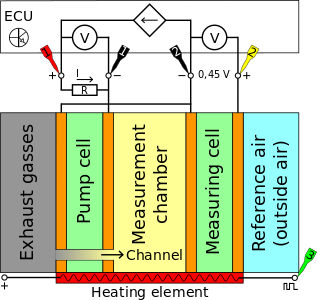
The sensor consist of three parts: pump cell, measurement chamber and measurement cell. The pump cell and measurement cell consist of a zirconium dioxide (zirconia) plate to which a thin layer of platinum is applied on both sides. When an oxygen concentration difference exists between the two sides, a voltage difference will be present between the two platinum plates. This voltage depends on the concentration difference and is about 450 mV for an ideal mixture.
The measurement cell is in contact with the outside air on one side and to the measurement chamber at the other. Opposite of the measurement cell, a pump cell is placed which can pump oxygen into or out of the measurement chamber by means of an electric current. A small amount of exhaust gases can flow into the measurement chamber through a small channel. This can change the oxygen concentration in the measurement chamber, changing the measurement cell voltage from its ideal value of 450 mV. To return then measurement cell back to 450 mV, the ECU sends a current through the pump cell. Depending on the direction and amount of current, oxygen ions can be pumped into or out of the measurement chamber to return the measurement cell voltage to 450 mV.
When a rich mixture is burned, the exhaust gases contain little oxygen and a current is sent through the pump cell to pump more oxygen into the measurement chamber. Conversely, when a lean mixture is burned, the exhaust gases contain a lot of oxygen and the current through the pump cell is reversed to pump oxygen out of the measurement chamber. Depending on the magnitude and direction of the current, the ECU changes the amount of injected fuel. When an ideal mixture is burned, no current flows though the pump cell and the amount of injected fuel remains unchanged.
For optimal performance the sensor needs to have a temperature of about 750°C. The sensor is equipped with a PTC resistance for electric heating, that is fed from the system relay or sometimes from the ECU. The negative side of the regulated heating is switched to ground by the ECU with a varying duty cycle signal.
Connecting the lab scope
Correct functioning of the broadband oxygen sensor can be checked by measuring the following signal voltages, see figure 1:
| Channel | Probe | Voltage | Range |
|---|---|---|---|
| 1 |  |
Positive side of pump cell | 800 mV |
 |
Negative side of pump cell | ||
| 2 |  |
Positive side of measurement cell | 800 mV |
 |
Negative side of measurement cell | ||
| 3 |  |
Sensor heating | 20 V |
 |
Ground at battery |
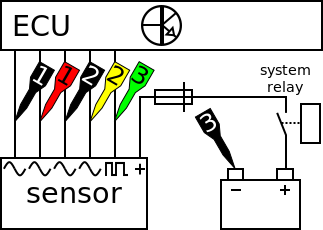
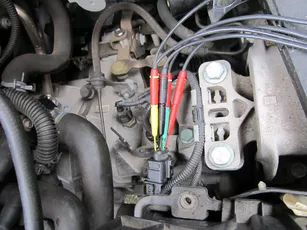
The lab scope is connected to the broadband oxygen sensor via a Measure lead TP-C1812B and Back Probe TP-BP85 and set to recorder mode. In recorder mode a streaming measurement is performed, continuously displaying the signals live on screen. Because the measured signals vary slowly, the Automotive Test Scope ATS5004D is set to a slow measuring speed.
Measuring
As explained above, the amount current flowing through the pump cell is a measure of the deviation from the ideal air to fuel ratio. To check the functioning of the sensor the current needs to be measured. The easy way to measure this current with out interrupting the circuit, is to measure the the voltage across the resistance that is in series with the pump cell to convert this back to a current value. In most cases the exact current value is not important and a voltage measurement will suffice.
Below, firstly a measurement of the pump cell voltage is treated. How this measurement can be used to determine the pump cell current is explained afterwards.
Measuring the pump cell voltage
Figure 4 shows waveforms of a broadband oxygen sensor with regulated heating, measured on a car with idling engine at operating temperature. This signal can be downloaded and used to correctly set up the lab scope or as reference signal.
Download broadband oxygen sensor voltage measurement
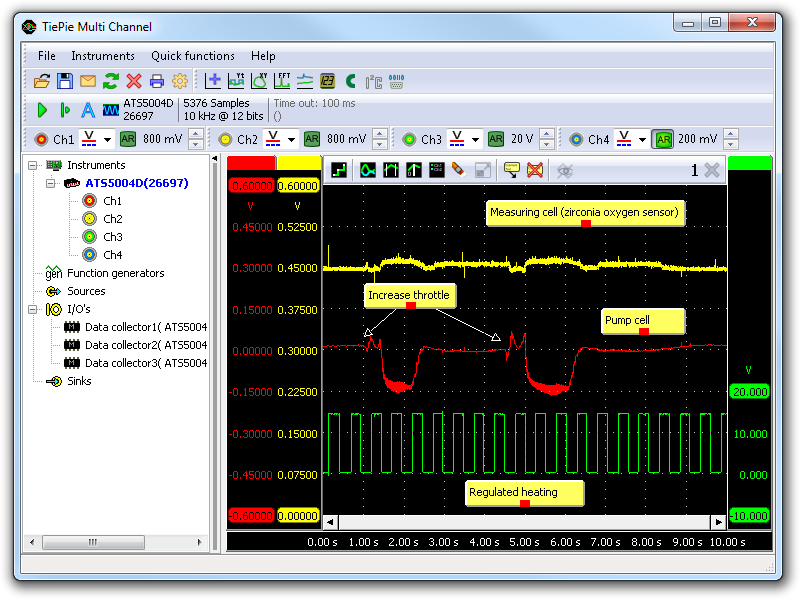
Channel 1 (red) shows the pump cell signal and channel 2 (yellow) the measurement cell signal. During this measurement the throttle is pressed twice, which can be seen in the small variations in the signals from the measurement cell and pump cell. The changes in the pump cell signal are caused by the ECU that changes the pump cell current to return the measurement cell signal back to 450mV. The slight variations in the measurement cell signal are present because the sensor and ECU have a certain reaction time to adjust the pump cell current. Channel 3 (green) shows the duty cycle-signal of the regulated sensor heating.
Measuring the pump cell current
The current through the pump cell can be derived from the voltage across the resistor that is in series with the pump cell (see figure 1) with the use of Ohm-law. This current is equal to the measured voltage divided by the resistance: I = V/R. Therefore, the current can be calculated from the measured voltage if the value of the resistor is known.
Determining the series resistance
Switch the car off completely before doing a resistance measurement. The resistance can be measured between two pins of the sensor connector if it is disconnected with the use of the resistance measurement of the Automotive Test Scope ATS5004D, see figure 5. The series resistance in this measurement example has a value of 77.8 Ohm.
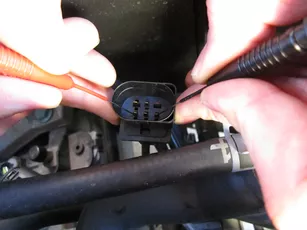
Now the value of the series resistance is known, a Gain/Offset I/O with gain set to 1/77.8 in the Multi Channel oscilloscope software can be used to convert the voltage of channel 1 to pump cell current. The unit of the Gain/Offset I/O is set to amps "A". The Gain/Offset I/O can be dragged into the graph to make the current visible.
Figure 6 shows the measurement again, but now with the pump cell current instead of the voltage across the series resistance. This signal can be downloaded and used to correctly set up the lab scope or as reference signal.
Download broadband oxygen sensor current measurement
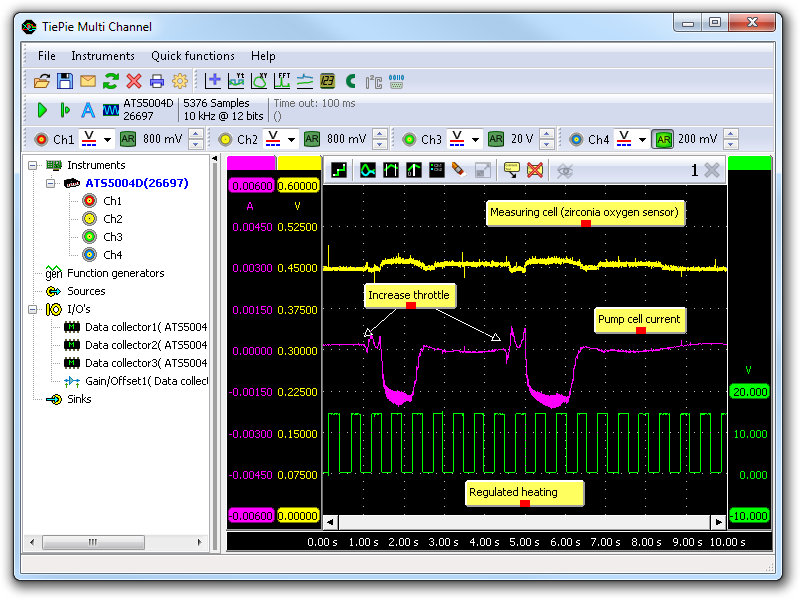
The voltage of channel 1 (red) is now converted to a current signal (purple) by a Gain/Offset I/O. The signals behave the same way as in the previous measurement.
Diagnosis
Signal values may differ on different types of engine control units and broadband oxygen sensors. Consult ATIS for information on specific engine control units and broadband oxygen sensors.
The following pump cell signal (channel 1) deviations can indicate a problem:
-
No signal:
Cause: back probes have no connection (perform a connection test), ECU amplifier defective, sensor defective -
Signal voltage too high:
Cause: mixture is too lean (check with gas analyzer), leak in exhaust system between engine and broadband oxygen sensor, sensor defective -
Signal voltage too low:
Cause: mixture is too rich (check with gas analyzer), sensor defective -
Signal shows more noise than example signal:
Cause: wiring of signal wire damaged, poor connection in connector terminals -
Signal shows an offset in relation to the example signal:
Cause: scope is not set to DC coupling: ,
sensor defective
,
sensor defective
The following measurement cell signal (channel 2) deviations can indicate a problem:
-
No signal:
Cause: back probes have no connection (perform a connection test), sensor defective -
Signal voltage too high:
Cause: mixture is too rich (check with gas analyzer), sensor defective -
Signal voltage too low:
Cause: mixture is too lean (check with gas analyzer), leak in exhaust system between engine and broadband oxygen sensor, sensor defective -
Signal shows more noise than example signal:
Cause: wiring of signal wire or ground damaged, poor connection in connector terminals, sensor defective -
Signal shows an offset in relation to the example signal:
Cause: scope is not set to DC coupling: ,
sensor defective
,
sensor defective
The following heating signal (channel 3) deviations can indicate a problem:
-
No signal:
Cause: back probes have no connection (perform a connection test), ECU amplifier defective, sensor defective -
Signal voltage too high:
Cause: poor or no ground for the ECU, resistance in wiring to ECU -
Signal voltage too low:
Cause: poor or no power supply -
Signal shows more noise than example signal:
Cause: wiring of signal wire damaged, poor connection in connector terminals -
Signal shows an offset in relation to the example signal:
Cause: scope is not set to DC coupling: ,
poor or no ground for the ECU,
resistance in wiring to ECU
,
poor or no ground for the ECU,
resistance in wiring to ECU
RELATED PRODUCTS
RELATED ARTICLES
- Oxygen sensor zirconia
- With a lab scope a zirconia lambda sensor is measured on an idling engine at operating temperature. The signal from the sensor is shown and can be downloaded. To help determining whether a zirconia lambda sensor and its heating is functioning correctly, different possible deviations from the example signals are mentioned along with probable causes.
- Toyota MR2 bad injector
- A Toyota MR2 is having problems after an engine replacement, fault code P0304 Cylinder #4 misfire detected occurs. The garage swaps several components but does not manage to fix the problem. Measurements with an automotive oscilloscope are required to find out that the fault code is somewhat misleading and the problem is not with cylinder #4
This document is subject to changes without notification. All rights reserved.
The information in this application note is carefully checked and is considered to be reliable, however TiePie engineering assumes no responsibility for any inaccuracies.
Safety warning:
- Before measuring, check that sources of dangerously high voltages are switched off or shielded from contact. Voltages considered to be dangerous are voltages over 30 V AC RMS, 42 V AC peak or 60 V DC.
- Keep a clean working environment when doing measurements.
- This measurement and procedures are a examples / measuring suggestions and are no prescribed protocols.
- TiePie engineering can not anticipate the safety actions that need to be taken to protect persons and appliances. Before starting a measurement, check which safety measures need to be applied.
